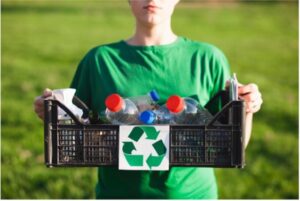Sustainable packaging under the PPWR: from ‘nice to have’ to ‘need to have’
Posted: September 20, 2024 | Author: Jasmin Buijs | Filed under: Advertising, Authors, Food |Comments Off on Sustainable packaging under the PPWR: from ‘nice to have’ to ‘need to have’Under the new packaging law, sustainability is no longer a ‘nice to have’ but a ‘need to have’. While companies currently distinguish themselves with recyclable and reusable packaging, this becomes the new normal under the Packaging and Packaging Waste Regulation (‘PPWR’). The PPWR is not yet formally adopted, though informal agreement has been reached at European level on the legislative proposal that was published by the European Commission in November 2022. The new regulation is expected to enter into force later this year.
The PPWR contributes to the transition towards a circular economy and builds on the current Packaging and Packaging Waste Directive, which it will replace. The first major difference can be seen in the mechanism of the law. It is no longer a directive that imposes obligations on Member States, but directly addresses economic operators such as food businesses. This includes shops and catering establishments offering refill and reuse items. The PPWR is a comprehensive piece of legislation. In this blogpost, we list three sustainability requirements under the PPWR that food businesses will face.
One of the first sustainability requirements mentioned in the PPWR is recyclability. This goal must be achieved in two steps. From 2030 onwards, packaging must be designed to be recyclable. A list of criteria showing when this requirement is met is yet to follow. This may mean, for example, that certain hazardous substances that affect the recycling process and make the recycled material unsafe are no longer allowed in packaging. Five years later, from 2035, packaging should actually be recycled in practice. The abovementioned entry deadlines will shift in case the European Commission does not publish on time its clarifying rules as required under the regulation.
For now, food packaging intended for vulnerable groups (think about persons using medical food and baby food), among others, is exempted. For innovative packaging that cannot meet the recyclability requirements taking into account current collection and recycling methods, a temporary five-year exemption can be applied for at national level.
(2) Percentage of recycled material
Plastic packaging still contains relatively little recycled material. In view of the European circularity targets, minimum percentages are now set for this. Taking into account the limited recycling possibilities and food safety, a lower minimum percentage will apply to food packaging than to non-food packaging (namely 30% and 10% from 2030 for PET and non-PET food packaging respectively, compared to 35% from 2030 for non-food packaging). With regard to single-use plastic beverage bottles, the PPWR will replace the minimum percentage of recycled material set for such in the Single Use Plastics Directive as from 2030 (30% by that year). From 2040, the minimum percentages will be further increased for all categories.
How the percentage of recycled plastic in packaging shall be calculated exactly is still to be defined. In any case, exceptions also apply to this sustainability requirement, especially where food safety may be at stake. Packaging with a plastic part representing less than 5% of the total weight of the whole packaging unit is also exempted from the mandatory minimum percentage.
Three years after the PPWR comes into force, certain packaging may only be offered in compostable form. In contrast, other packaging may explicitly not be marketed as such, unless such packaging was subject to national compostability requirements before the date of application of the PPWR. The compostability requirement will initially apply to sticky labels attached to fruit and vegetables, and to packaging like permeable tea bags and coffee pads. Aluminum coffee capsules are thus not covered. Non-permeable coffee capsules made of other material may be accepted for composting at national level.
‘Compostable’ under the PPWR means that the packaging complies with the European standard for industrial composting (13432). However, this standard does not match real life industrial composting and will therefore be updated. Member States may as well require that the packaging complies with the standard for home composting. Needless to say, this is a tougher standard. For the time being, the Netherlands has not indicated its intention to make use of this policy freedom.
Chain responsibility
The responsibility to meet the above sustainability requirements lies primarily with manufacturers. These are the (legal) persons who manufacture packaging or a packaged product, or who have such designed or manufactured under their own name or trademark (save for some exceptions). A food company that manufactures (itself) or has manufactured (by a third party) packaged food products is therefore a manufacturer under the PPWR. Manufacturers will have to carry out a conformity assessment. In doing so, they guarantee and declare under their own responsibility that the packaging complies with the relevant provisions of the PPWR. As part of this, the manufacturer shall draw up a dossier demonstrating compliance.
Food companies importing packaging or packaged products from third countries (importers) will have the responsibility to check whether such packaging complies with the Union rules laid down in the PPWR. Should there be a suspicion that the packaging does not comply with the law, this must be corrected. Importers must in such case also inform the competent authority. To avoid misunderstandings and conflicting interests, it is recommended that food companies make contractual agreements on this with their suppliers and/or customers. This also applies to food companies that further market packaging or packaged products on the Union market (distributors). Distributors should also actively ensure that the packaging meets the labelling requirements under the PWWR. This includes facilitating the correct disposal route and combating ‘greenwashing’.
The PPWR is a dynamic legislative document. Several criteria still need to be fleshed out in secondary legislation and the PPWR leaves a lot of room for evaluation, additions and deletions (the latter especially with regard to the exemptions it currently contains). However, sitting still and waiting for more clarity is not recommended since developments are moving fast. Our advice: take stock of the current situation within your company, start talking to your suppliers and customers, and check whether current contracts need to be adjusted. And above all, evaluate which sustainability improvements can be made. Because one thing is certain: the EU needs to step up its efforts to become climate neutral by 2050.
A Dutch version of this blogpost is available at VMT.nl.
All images are by freepik.



